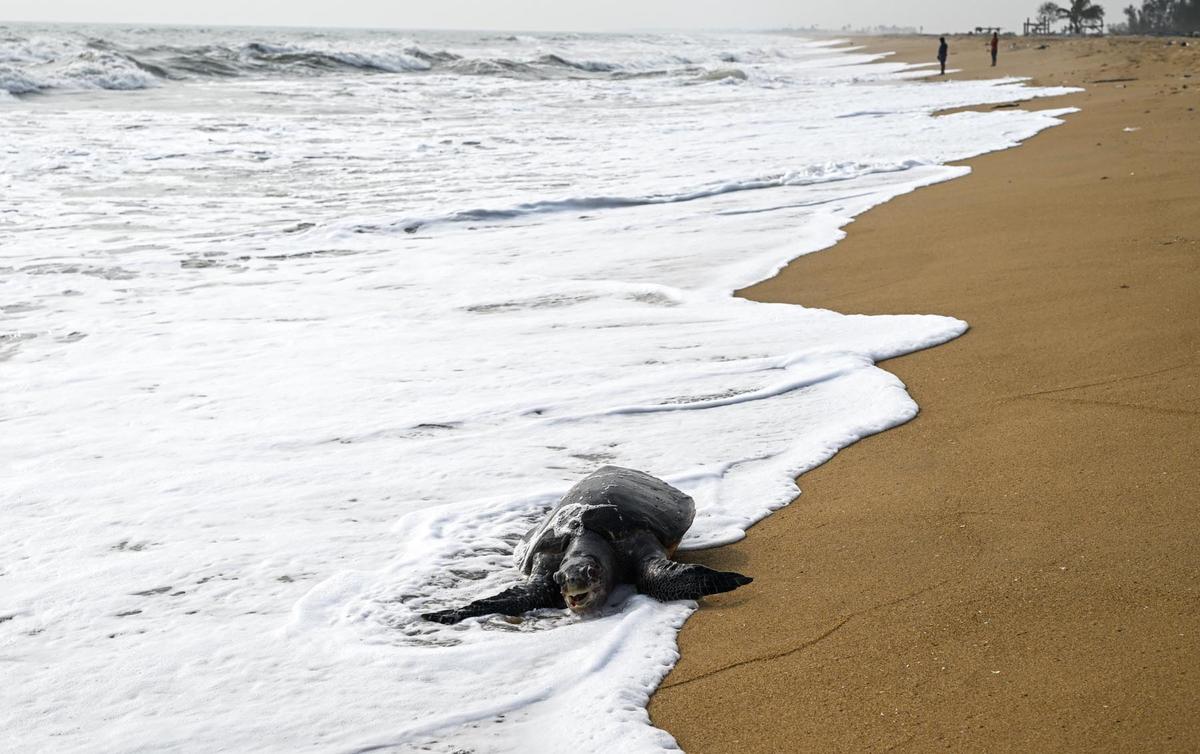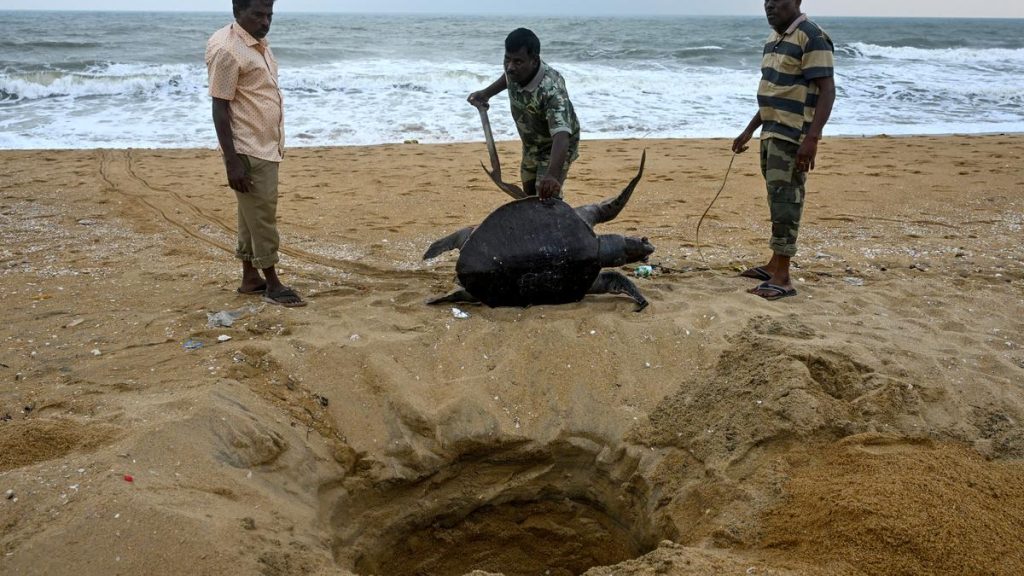On a sunny day in January, A. Prakash, 40, sits on a boat in Kovalam, off the East Coast Road (ECR) in Chengalpattu district of Tamil Nadu. He has just returned from a fishing trip where he saw 10 Olive Ridley sea turtle carcasses floating in the sea. “We (fisherfolk) have been seeing many such carcasses every day since the beginning of the year,” he says, perturbed.
Prakash points to an elderly woman nearby, who comes to pick up a basket of tiger prawns from the boat, and says her son helps the Forest Department bury the carcasses. Placing the basket deftly on her head, Rani, 65, says, “My son just buried six and came home tired and hungry.”

In the Chennai and Chengalpattu districts, located along the 1,076 kilometre-long coastline of Tamil Nadu, many people recall seeing dead Olive Ridley sea turtles washed ashore this year. C. Gnanasekar, 44, a fisherman from Uthandi, off ECR, spotted four of them in the first week of January. Rajiv Rai, 69, from Injambakkam in Chennai, says he has seen about 80 since the first week of the year. Maria, a nature enthusiast, says she saw 24 at Nemmeli Kuppam in Chengalpattu.
Olive Ridley turtles, which are found in warmer waters, such as the southern Atlantic, Pacific, and Indian Oceans, haul themselves up on to India’s eastern shore every year by the tens of thousands and lay eggs in an event known as arribada (arrival by sea in Spanish). While Odisha is a mass nesting site for Olive Ridley turtles in India, thousands of these small wild animals also come sporadically to nest between December and April along the Tamil Nadu coastline, a lifeline for millions who depend on fishing for their livelihood. The biodiverse and eco-sensitive Gulf of Mannar, located off the districts of Thoothukudi and Ramanathapuram in the south, is an essential feeding site for these turtles. The creatures then migrate to Odisha, West Bengal, and beyond.
Along the 34-km coast from the Marina Beach in Chennai to Kovalam in Chengalpattu, seeing dead sea turtles on the shore during mating season is not unusual — every year, an average of 350 dead turtles can be found, says Shravan Krishnan, a volunteer with the Students Sea Turtle Conservation Network (SSTCN). However, this year, until January 31, conservationists had counted 1,200 dead sea turtles, more than three times the normal figure. The Tamil Nadu Forest Department provided a more conservative estimate (706 turtles until January 23). The Department has refused to provide numbers since then.
Along the 34-kilometre coast from the Marina Beach in Chennai to Kovalam in Chengalpattu, seeing dead sea turtles on the shore during mating season is not an unusual phenomenon, but the number this year has been unprecedented.
| Photo Credit:
R. Ravindran
To make matters worse, the number of sea turtle nests along the shores has been unusually low. “Most turtles that were to nest have died. All the dead female turtles we bury have eggs in their bodies,” says Gnanasekar, who has been working with the TREE Foundation, a marine conservation organisation, for two decades.
Guests from the sea
Olive Ridleys are the smallest of the seven sea turtle species. They weigh up to 45 kilogrammes and reach only about 2 feet in shell length. Their name comes from their olive-coloured carapaces (hard upper shells). Though their numbers have remained stable in recent years, Olive Ridleys remain a key species in global conservation efforts and are classified ‘vulnerable’ by the International Union for Conservation of Nature Red List.
Sea turtles play a crucial role in the marine ecosystem. By feeding on crustaceans that live on the seabed, they help release the oxygen that is trapped there. They maintain healthy seagrass levels by nibbling on seagrass and algae. They provide shelter for commercially important fish species and control jellyfish populations that could otherwise harm fish larvae.
In Tamil Nadu, conservationists and fisherfolk refer to Olive Ridley turtles as “guests” and even “god”. For fishermen such as A. Palayam, 62, from Urur Kuppam in Besant Nagar in Chennai, sea turtles have a cultural and spiritual significance. “Our kutti amma (little mother) is important for us,” he says. In addition to the creature’s cultural significance, fisherfolk view sea turtles as a symbol of a healthy ecosystem.
Every year, Olive Ridleys pore out of the sea, crowd the shore, give birth, and then wait to be swept into the sea again. Referring to this, R. Sankari, 37, a resident of Nemmeli, says, “The turtles are like the daughters of our village. They come back to their home to have children.” Sankari says she has been seeing an unusually high number of dead turtles this nesting season.
In Chennai, one of the few metropolitan cities in India where these sea turtles come to nest, it is not just fisherfolk who speak passionately about turtles; conservationists and students sport T-shirts urging people to save turtles and set off at midnight during the nesting season to scour dark sands for eggs.
Abhishaek, 24, a volunteer with SSTCN, and his peers patrol two stretches of the coast between the Cooum estuary and Neelankarai every night in the nesting season. As they walk, they search for tracks left by the turtles and follow them. When they come across a distinctive clearing, they use a ‘probe’, a long hollow rod, to check for nests. If they find eggs, they carefully collect them and measure the nest’s dimensions to recreate the conditions in hatcheries, before continuing their walk. “Working with a community that cares so much about sea turtles has shaped my interest in wildlife conservation. Sea turtles are a huge part of my life,” he says.
Abhishaek, who has spent four years with SSTCN, says the team hardly found nests in the first three weeks of January. “Typically, we find about 30 nests. But this year, we could find only two,” he says.
Nets of destruction
By the end of January, conservationists and authorities in Andhra Pradesh also began to notice that the number of dead turtles was higher than normal. C. Selvam, Conservator of Forests in the Tirupati Circle of the Andhra Pradesh Forest Department, says the problem is not confined to Tamil Nadu. Supraja Dharini, founder of the TREE Foundation who also works with the Andhra Pradesh Forest Department, says at least 2,032 turtles had died until January 26 in the State.
Dharini says one of the primary threats to sea turtles is bottom trawling and the widespread use of fishing gear, such as gill nets. The Tamil Nadu Marine Fishing Regulation Act, 1983, stipulates that trawl boats should operate beyond 5 nautical miles (approximately 9.26 km) from the shore. This zone is reserved for artisanal fishermen using smaller boats. “However, despite regulations, many commercial fishermen continue to violate these rules,” Dharini says. “When trawl boats often encroach into restricted areas, it increases the risk of turtle entanglement and death.”
R. Suresh Kumar, a wildlife biologist at the Wildlife Institute of India, explains that turtles don’t just visit nesting beaches but congregate in specific areas before nesting. “Destructive fishing practices such as trawling and gill netting in these aggregation zones could be a significant factor in the rise in deaths,” he says.
Acknowledging the harmful effects of trawling, K. Bharathi, president of the South Indian Fishermen Welfare Association, says those who violate the law should be penalised. However, the government has failed to provide any viable alternatives to commercial fishing, he adds.
After news reports of the high number of turtle deaths emerged, the Tamil Nadu government formed a task force headed by the Principal Chief Conservator of Forests and Chief Wildlife Warden, Rakesh Kumar Dogra. On January 27, the task force decided to strengthen regulations on trawl fishing, enforce the use of Turtle Excluder Devices (TEDs), and restrict the horsepower of boat engines.
TEDs are metal grids designed to allow turtles to escape from trawl nets. But fisherfolk have expressed concerns that these devices could reduce their catch. A fisherman working on a mechanised boat in Kasimedu explains that with dwindling resources in the ocean, even a small fall in catch can have a significant impact on his profits. “There have been no efforts from the Fisheries Department to introduce improved TED models or compensate fishermen for the months they are required to use them,” he says.
Kumar refutes this. He says TEDs do not result in significant catch loss. He explains that larger fish typically do not travel in schools and are not often caught in trawl nets.
The government has also increased joint patrols involving the Fisheries Department, Forest Department, Indian Coast Guard, and Marine Police. According to Dogra, long-term studies and monitoring, including telemetry research, will also begin soon. Plans have also been put in place to involve police authorities in monitoring and addressing trawler violations.
Meanwhile, the Southern Bench of the National Green Tribunal took suo motu notice of the issue on January 18 and criticised the Tamil Nadu government for failing to regulate trawlers and enforce the use of TEDs despite previous orders.
The surge in turtle deaths also coincided with an unusually rough monsoon season. Fishermen report that the seas have been particularly turbulent as the north-east monsoon of 2024 persisted well beyond its usual last date of December 31, as per the India Metereological Department.
Palayam argues that it’s not fair to place the blame solely on fishermen. He has been tracking currents and wind patterns every day since 2018 and notes that this season has been unusual. “During the onset of the Tamil Thai month, the sea is typically calm. But that hasn’t been the case this year. The olini (easterly) current could push objects back to the shore, which could explain how dead carcasses from Andhra Pradesh could be washing ashore in Chennai,” he says.
A collaborative effort
Kartik Shanker, an ecologist and author of From Soup to Superstar: The Story of Sea Turtle Conservation Along the Indian Coast, believes that many of the regulations that are necessary to protect turtles are already covered by fisheries laws; the challenge lies in improving compliance with the engagement of all stakeholders, especially traditional fishermen.

Along the 34-kilometre coast from the Marina Beach in Chennai to Kovalam in Chengalpattu, seeing dead sea turtles on the shore during mating season is not an unusual phenomenon, but the numbers this year have been unprecedented.
| Photo Credit:
B. Jothi Ramalingam
Shanker also points out that a specific focus on turtle conservation can sometimes be counterproductive, leading to conflicts between sectors. “Sea turtle populations are increasing in many parts of the world, including on the east coast, but we need to make fishing regulations effective for the integrity of coastal ecosystems because bottom trawling is a destructive practice. Trawling tends to tear up the seafloor, causing damage to the entire habitat, not just turtles,” he says.
Kumar says protecting critical turtle habitats can also benefit local fishermen. “When we secure areas for turtles, it’s not just good for conservation, but also supports the livelihoods of artisanal fishermen, who do not go venture deep into the sea,” he says.
This is not an easy task, he adds. “The Tamil Nadu Forest Department must collaborate closely with fishermen, while the Fisheries Department needs to take a more serious approach to understanding where and what type of fishing is occurring,” he says.
The pressure on the marine industry is immense, with demands for both local consumption and exports. “We need to conduct tracking studies specific to this coast. We can’t just replicate what works in other regions,” Kumar insists.
Selvam calls for a more unified approach that includes identifying key mating and congregation areas in the sea. This strategy should involve the Fisheries Department and local communities more closely, he says. However, the department has limited resources and manpower, which makes it difficult to enforce regulations effectively. Monitoring such vast ocean areas is also a logistical challenge. “Collaboration between fishermen, conservation groups, and the use of technological tools like apps to track turtle activity will be crucial,” he says.
Fishermen point out that in addition to trawlers, gill nets, and squid nets, the sea turtles face significant threats from the plastic waste that floods the ocean. “Why can’t the government build a structure to prevent plastics from entering the sea,” asks Gnanasekar.
Palayam also raises concerns about the growing number of hard structures, such as groynes, being built along Tamil Nadu’s sandy beaches, which damage the nesting habitats.
“Over the years, we have noticed that when the turtles come to nest, they find the sand polluted and return without nesting,” says Abhishaek.
Saving the turtles is about safeguarding the future of both the sea and the people who rely on it. Sankari says, “I remember my father offering prayers if a sea turtle accidentally got caught in his net. He wouldn’t go out to sea for a day. If the turtles are in trouble, how will we survive?”
geetha.srimathi@thehindu.co.in
Published – February 08, 2025 02:30 am IST







